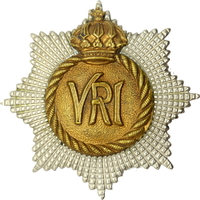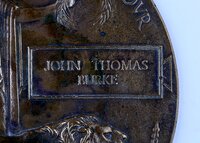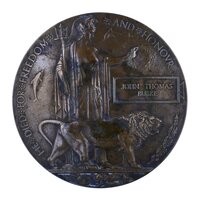
415026 Private John Thomas Burke
40th Canadian Overseas Battalion
The Royal Canadian Regiment
By: Capt (ret'd) Michael M. O'Leary, CD, The RCR
John Thomas Burke was born in Bay St. Lawrence, Cape Breton, on 15 Jul 1891. (Discrepancies on his First World War attestation paper give the year of birth as 1893, and place Bay St. Lawrence in "Inverness Co., Quebec.") Burke's family, led by parents John T. and Elizabeth, can be found in the 1901 Canadian Census. The appearance of the family shows John (32) and Elizabeth (40) with four children: Daniel (10), John T. (9), Barbara E. (7), and Annie (1). A step-daughter, Cate A. Haug (16) also lives with the family.
A pay card for the 40th Battalion was started for Burke on 28 May 1915. This is likely the date he began his travel to where the 40th Battalion was mustering at Camp Aldershot, Nova Scotia. A few days later, on 1 Jun 1915, he was medically examined at the Camp for his fitness to serve in the C.E.F.
Burke officially attested for service in the Canadian Expeditionary Force (C.E.F.) with the 40th Overseas Battalion at Camp Aldershot, N.S., on 5 Jun 1915. A 22-year-old barber, Burke was described on his attestation paper as 5 feet 8 1/4-inches tall, with a 34-inch chest, a fresh complexion, blue eyes, and brown hair. His religious denomination was Roman Catholic. Burke identified his father, John Burke, Dominion No. 1, Cape Breton, as his next of kin. On attesting with the 40th Battalion, Burke was given the regimental number 415026.
The 40th Battalion was authorized on 1 Jan 1915, the unit recruited in Nova Scotia, and was mobilized at Camp Aldershot. The following month the battalion was moved to Camp Valcartier for training. Having previously despatched two 250-man drafts of reinforcements in June and early October, 1915, the battalion, still over 1100 strong, embarked at Quebec on 18 Oct 1915. Following its arrival in England on 29 Oct 1915, the unit provided reinforcements to the Canadian Corps as the 40th Reserve Battalion until until 4 Jan 1917, when its remaining personnel were transferred to the 26th Reserve Battalion, C.E.F.
When the 40th Battalion sailed for England, John Burke was not with them. While at Camp Valcartier, Burke deserted His Majesty's Service on 19 Sep 1915.
Almost eight months later, John Burke, C.E.F. deserter, was apprehended by Military Police in Cape Breton on 8 May 1916. Taken back on the strength of the C.EF., and nominally of the 40th Battalion, Burke remained in military custody while being transported overseas to rejoin the battalion at St Martin's Plains, England.
Burke would remain in custody a total of 43 days before being tried by Court Martial for desertion. An entry dated 19 Jun 1916 in his service record succintly states: "Sentenced by D.C.M. to undergo detention for one year for Deserting H.M.S. Confirmed 20 Jun 1916. Forfeits pay and allowances from 8 May 1916. (3 months remitted.)"
The Court Martial record held by Library and Archives Canada offers a more detailed overview of his judicial process.
Conducted at Dibgate on 16 Jun 1916, the details of Burke's Court Martial are recorded on Army Form A.9, Form of Proceedings for District Courts-Martial. Ordered by Major General S.B. Steele, C.B., M.V.O., Commanding Troops, Shorncliffe, the court consisted of three officers, a President and two Members. A fourth officer was detailed a prosecutor:
- President ⁚ Lt.-Col. W.S. Buell, attached, 36th Res. Bn., C.E.F.
- Members ⁚
- Major A.G. Tweedie, 37th Res. Bn., C.E.F.
- Capt C.E. Williams, 55th Res. Bn., C.E.F.
- Prosecutor ⁚ Capt W.E. Doane, 40th Res. Bn. C.E.F.
The accompanying Charge Sheet provided details of Burke's crime:
"The accused No. 415026 Private John Burke, 40th Canadian Reserve Battalion, attached 12th Canadian Reserve Battalion, Canadian Expeditionary Force, a soldier of a Force raised in a Colony and doing duty with the Regular Forces in the United Kingdom, is charged with,
"When on Active Service,
"Deserting His Majesty's Service, in that he,
"At Valcartier, P.Q., on the 19th day of September, 1915, absented himself from the 40th Battalion, C.E.F. until apprehended by the Military Police at Sydney, Cape Breton, about the 8th of May, 1916.
To the crime of desertion, Burke pleaded: "Not Guilty."
The prosecutor called the first witness, which was himself. Capt Doane stated:
"I produce the original declaration of Court of Inquiry declaring the accused illegally absent from 19th September 1915, and signed at Valcartier, P.Q., on the 13th day of October, 1915."
The record of the Court of Inquiry listed clothing and necessaries totally a little over $43.00 in value which disappeared with Burke. It is unknown how much returned with him when he was apprehended.
Pte. Burke did not cross-examine the first witness.
The second witness called was 415004 C.S.M. J. Chapman, 40th Res. Bn. C.E.F., who stated:
"At Valcartier, P.Q., I was acting Sergeant Major of "C" Company, 4th Bn., C.E.F., when the accused was reported absent. I know the accused well. I was accustomed at that time of helping the Orderly Sergeants make out the Tattoo reports. I never saw the accused from that time until two weeks ago this coming Wednesday."
Pte. Burke did not cross-examine the second witness.
The third witness called was 415129 Pte. E. Mansfield, 40th Res. Bn. C.E.F., who stated:
"I went in company with Corporal Allaby of the 40th Bn., C.E.F., and escorted the accused from the Cavalry Depot to the 40th Bn. Guard Room, Down Dibgate. This was some weeks ago."
Pte. Burke did not cross-examine the third witness.
Having chosen not to question any of the witnesses, Burke offered no material evidence on his own behalf and called on no witnesses. In his own defence he made the following statement:
"I left Valcartier the 18th day of September, 1915, to go home to see my mother who was seriously ill in Cape Breton. I had no money to take me back. I went to the nearest Recruiting Officer who was at Sydney, and found that he, Capt. Florence, was away in Halifax. Before he got back the Battalion left Canada. I fully intended to return had I been given transportation. I was in uniform when I was apprehended by the Military Police at my home five miles from Sydney about the 8th day of May, 1916. I was four months with the battalion before leaving. I had never received any leave. I stayed at home all the time."
The finding of the Court was recorded as: "The Court find that the accused, No. 415026 Pte. John Burke, 40th Res. Bn., C.E.F., is guilty of the charge."
Capt Doane was sworn back in by the Court to represent the 40th Battalion in presenting evidence on behalf of Burke's character. He provided a copy of Burke's Army Form B.296, Statement as to Character and Particulars of Service of Accused, which including his conduct sheet. In Burke's favour, the latter had no prior entries. The form presented by Capt Doane showed that Burke had been in Military Custody awaiting court martial for 43 days.
The sentence pronounced by the Court was: "The Court sentences the accused No. 415026 Pte. John Burke, 40th Res. Bn., C.E.F., to undergo detention for one (1) year."
Major General Steele confirmed the sentence and remitted three months of the detention awarded, leaving nine months detention to be served.
It appears that Burke actually served about six months of his sentence. On 4 Jan 1917 he was transferred from the the 40th Battalion to the 26th Reserve Battalion. About six weeks later, on 16 Feb 1917, he joined a draft for overseas and was struck off the strength of the 26th Res. Bn. to The RCR in France.
Crossing the Channel and arriving at the Canadian Base Depot, Burke was taken on the strength of The RCR on 22 Feb 1917. Five days later he arrived at the Regiment.
Burke joined the Regiment in the field on 27 Feb 1917. He was in the ranks for the final preparations for and the assault on Vimy Ridge. Throughout the year that followed, The RCR followed the cycle of rotations in forward trenches, support trenches, and reserve positions that would characterize the infantry experience of the Great War. The Battle Honours awarded to the Regiment for actions in 1917 indicate the intensity of his experiences as a Great War infantry soldier:
- Arras, 1917
- Vimy, 1917
- Hill 70
- Ypres, 1917
- Passchendaele
Having survived those battlefields, Burke landed in hospital for a few days in November, 1917, with a sprained ankle. Spending a further week "sick" he completed a new Military Will form in his soldier's pay book on 23 Nov 1917. In this will, he declared: "In the event of my death I leave the whole of any property and effects including deferred pay and surplus of credit due to me, to my mother Mrs. E. Burke, North Sydney, N.S., C.B."
Burke rejoined the unit on 25 Nov 1917 and in December was granted 14 days leave in England.
During the first seven months of 1918, as the cycle of front line, support, and reserve trenches continued, Burke found time to cross paths with the military's justice system a few times. On 10 Feb 1918, he was caught removing property (i.e., timber) from Government Huts and charged for the crime. Four days later, at a summary trial, he was found guilty and sentenced to seven days of Field Punishment No. 1.
Major E.W. Pope, an officer of The RCR, authored a small guide to military law during the war in which he described the conditions for Field Punishment No. 1 (F.P. No. 1).
Field Punishment No. 1
"Where an offender is sentenced to Field Punishment No. I, he may, during the continuance of his sentence, unless the Court Martial or the commanding Officer otherwise directs, be punished as follows:
"(a) He may be kept in irons, i.e. in fetters or handcuffs, or both fetters and handcuffs; and may be secured so as to prevent his escape.
"(b) When in irons he may be attached for a period or periods not exceeding two hours in anyone day to a fixed object, but he must not be so attached during more than three out of any four consecutive days, nor during more than twenty-one days in all.
"(c) Straps or ropes may be used for the purpose of these rules in lieu of irons.
"(d) He may be subjected to the like labour, employment, and restraint, and dealt with in like manner, as if he were under a sentence of imprisonment with hard labour.
Where an offender is sentenced to Field Punishment No. 2, the foregoing rule with respect to Field Punishment No. 1 shall apply to him, except that he shall not be liable to be attached to a fixed object as provided by paragraph (b) of Rule 2.
"Many officers have an idea that Field Punishment No. I consists in merely tying a prisoner to a fixed object for a certain length of time each day. This is quite wrong. The proper system is to make a man sentenced to this punishment do all the fatigues and sanitary work possible in the vicinity of the billets which his unit is occupying, with a view to relieving well-conducted men there-from. Then when there is nothing left for him to do of that nature, he can be tied to a fixed object for a period not exceeding two hours daily. When it is decided to tie a prisoner to a fixed object, it has been found advisable to carry out this punishment in as public a place as possible." (The Canadian Officer's Guide to the Study of Military Law, by Major E. W. Pope, The Royal Canadian Regiment (Methuen & Co. Ltd., 1916))
Burke was charged again, this time with drunkenness while on active service, on 25 Apr 1918. The Regiment would not be able to conduct his summary trial until 11 May 1918, at which a guilty verdict resulted in a punishment of a further 28 days F.P. No. 1.
On 26 May 1918, Burke was charged with "Disobeying an order." Three days later he was sentenced to 10 days Confinement to Barracks (C.B.).
Burke stayed out of trouble during the summer of 1918 after his third summary punishment.
On 8 Aug 1918, The RCR moved forward once again to attack the German lines. The regimental history (Fetherstonhaugh, 1936) sets the scene for the day:
"Moving forward ... on the night of August 7 from the concentration positions of the 7th Brigade in Gentelles Wood, The Royal Canadian Regiment reached the assembly positions at 1.20 a.m. on August 8 and at 4.15 a.m. proceeded by Infantry Tracks Nos. 1 and 2 towards the banks of the River Luce. Five minutes later, at 4.20 a.m. exactly, the British guns opened and, as the first lines of the assault advanced, there began the "Hundred Days" which were to witness the downfall of the German Army and Empire."
The Regiment's actions were successful and the regimental history summarized the results of the day:
"By this time Battalion Headquarters had received word that all objectives had been taken and also some details of captures and losses. "C" Coy. reported only eight casualties, more than offset by the captures of guns and prisoners noted above; "A" Coy. had suffered 26 casualties, but had captured approximately 90 prisoners, 3 field guns, and 8 machine-guns. The supporting companies had not reported the details of their casualties at this time, but it was known that their losses had been few and consequently that the Battalion's total of prisoners alone must many times exceed the aggregate of its casualties."
Unfortunately, Private John Burke was not able to celebrate the Regiment's success, he was one of those who fell during that day's fight. He was killed in action on 8 Aug 1918
Pte. John Thomas Burke, The RCR, has no known grave. He is commemorated on the Vimy Memorial.
There is no Circumstances of Death form to provide details of Burke's death. One of many lost with no surviving witness to the manner of his death. A Graves Registration form held by the Commonwealth War Graves Commission notes an "Unconfirmed Burial Report" stating "Beaucourt British Military Cemetery. Sheet 66E.D21.a.6.7."
The cemetery named on the form and the military map grid reference do not match. It is possible that the grid reference was the location of an temporary battlefield burial, and by the time the report was made the cemetery was assumed to be the location his remains were moved to. Beaucourt British Cemetery is about 2000 yards (1800 m) east and south of the noted map location. The cemetery is known to have one unidentified burial, but the remains that grave contains are also known to be a Lance Corporal.
It is more likely that Burke's remains were recovered and moved to Mezieres Communal Cemetery Extension. This cemetery, closer to the noted grid reference and about 750 yards (685 m) to the south west, contains 134 burials, of which 63 are unidentified.
For his service in the C.E.F., Burke was entitled to receive the British War Medal and the Victory Medal. These were despatched to his mother at North Sydney, N.S, on 31 Oct 1922. Elizabeth Burke also received a silver Memorial Cross. Burke's father received the Memorial Plaque and Scroll commemorating his death. The plaque and crosses would be despatched in 1920 and 1921.
Pro Patria
Visit a randomly selected page in The O'Leary Collection (or reload for another choice):
![]()
![]()
![]() 455751 A./Corporal Warren Merton Hartley
455751 A./Corporal Warren Merton Hartley
Under-aged soldier in the First War; RCAF radar officer in the Second.
- The O'Leary Collection; Medals of The Royal Canadian Regiment.
- Researching Canadian Soldiers of the First World War
- Researching The Royal Canadian Regiment
- The RCR in the First World War
- Badges of The RCR
- The Senior Subaltern
- The Minute Book (blog)
- Rogue Papers
- Tactical Primers
- The Regimental Library
- Battle Honours
- Perpetuation of the CEF
- A Miscellany
- Quotes
- The Frontenac Times
- Site Map
QUICK LINKS
The O'Leary Collection—Medals of The Royal Canadian Regiment
Newest additions:
![]()
![]() SB-12725 Private Henry "Hank" Ard
SB-12725 Private Henry "Hank" Ard ![]()
WIA at Hill 187, Died of Wounds in Japan
![]()
![]() 2355331 Lance Corporal Albert Lorking
2355331 Lance Corporal Albert Lorking
Wounded in action, later a War Amps representative.
![]()
![]() 4334 / 477996 Pte Isaac Hamilton Wilcox
4334 / 477996 Pte Isaac Hamilton Wilcox
Permanent Force, South Africa, and C.E.F.
![]()
![]() 477019 Private Harold Ashcroft
477019 Private Harold Ashcroft
Transferred to the Tunnelers.
![]()
![]() 734231 Private Clark D. Thompson
734231 Private Clark D. Thompson ![]()
The older Thompson brother, killed in action.
![]()
![]() 733849 Private Norman Parker Thompson
733849 Private Norman Parker Thompson
The younger Thompson brother; post-war service in the Special Guard.
![]()
![]()
![]() A305 / 400305 Private Andrew Walker
A305 / 400305 Private Andrew Walker ![]()
"Previously reported Wounded, now Killed in Action."
![]()
![]() 823298 Pte Thomas Patrick Steele, M.M.
823298 Pte Thomas Patrick Steele, M.M. ![]()
… for gallant conduct in the field …
![]()
![]() P13066 Sergeant Harold Thompson
P13066 Sergeant Harold Thompson
Instrumental Soloist for over 20 years of Canadian Army service.
![]()
![]() 9609 / 477728 Private Albert Edward Piper
9609 / 477728 Private Albert Edward Piper
"Arrived from England as a STOWAWAY …"



